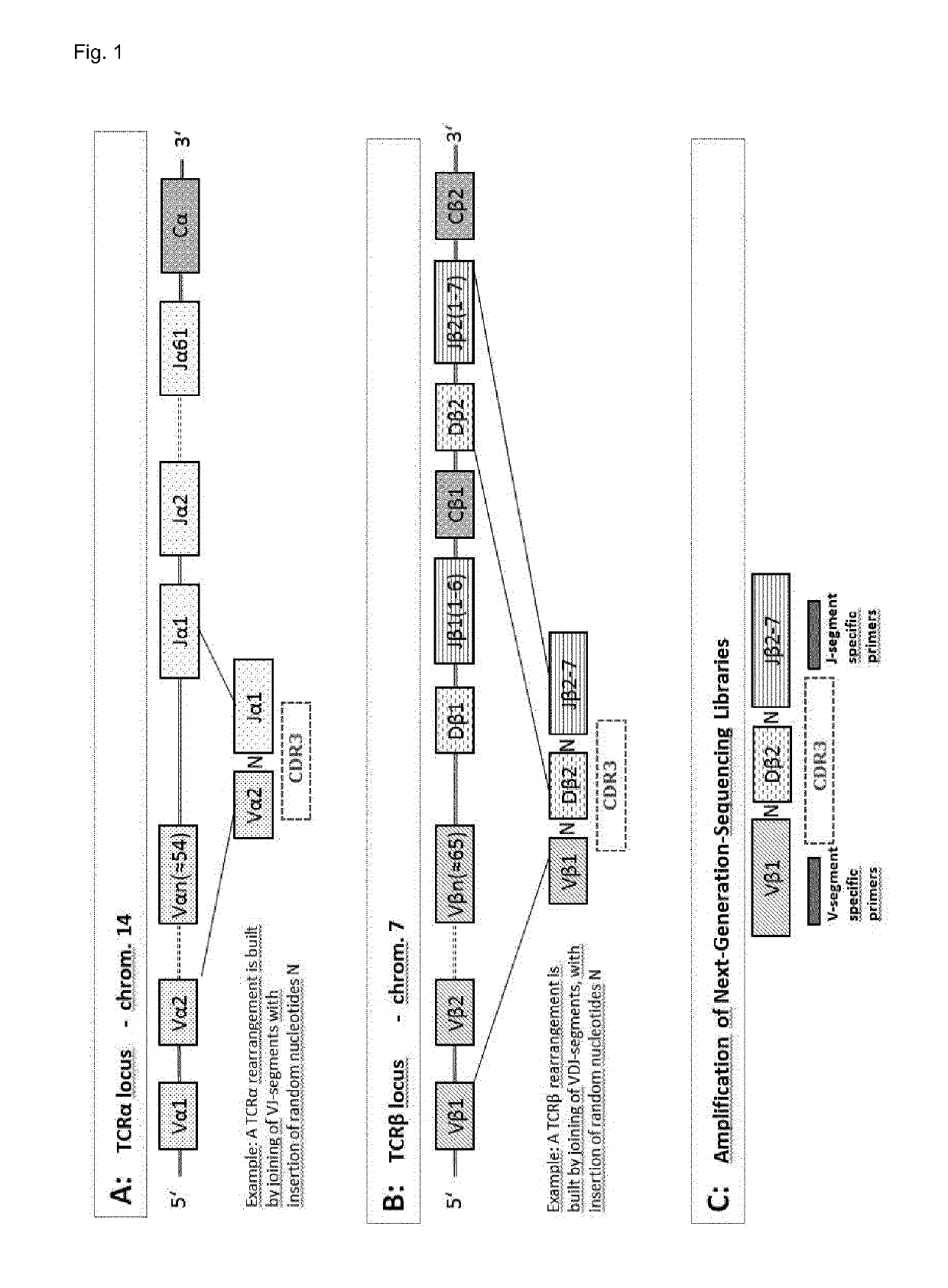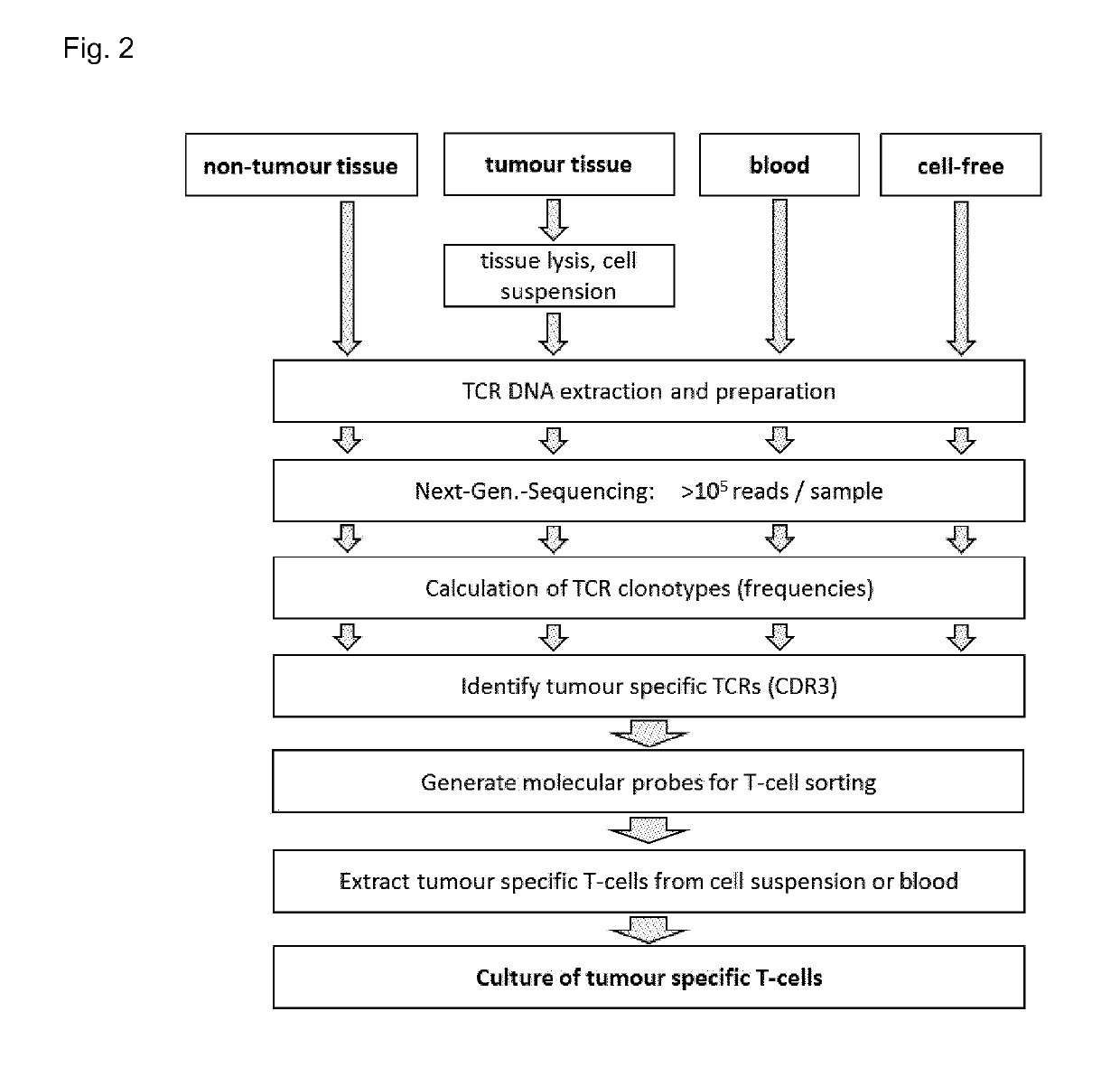Method for providing tumour-specific t cells
- Summary
- Abstract
- Description
- Claims
- Application Information
AI Technical Summary
Benefits of technology
Problems solved by technology
Method used
Image
Examples
example 1
ation of Tumour-Specific T Cells and Tumour-Specific Sequences by Comparative Sequence Analysis
[0361]Available Next-Generation-Sequencing (NGS) technology was used to sequence many thousand TCR beta CDR3 regions (one TCR corresponds to one T cell) per sample in high-throughput, whereby sequencing libraries for the CDR3-region of human TCR beta were generated. The resulting sequences were analysed by bioinformatics tools and the final result per sample is a table listing the respective clonotypes (types of T cells with the same TCR beta).
[0362]The CDR3 region of the T cell receptor is determined by the constant V- and J-segments (see FIG. 1) and the highly variable regions between them. Due to this structure one and the same CDR3 amino acid sequence can be encoded by multiple nucleotide sequences, which may be even composed of distinct V / J-segments. The occurrence of multiple (>1) nucleotide CDR3 sequences per one amino acid sequence among the set of tumour-specific T cells and poten...
example 2
quence Identification
[0395]Once the TCR nucleic acid sequences of the T cell clones of interest are identified, further steps are necessary to define the ideal target sequences that can be used for detection and enrichment of said T cell clones. At first, the specific genomic sequence is used to generate an at least partial mature mRNA sequence in order to discard any intronic parts that cannot serve as target for specific recognition by probes in living cells. Said clonal mature mRNA sequences are then compared with the complete transcriptome including the mature TCR mRNA of all other T cells not belonging to the clones of interest in order to identify only target-specific sequences. Particularly, mainly the CDR3 regions of the TCR mRNA are different on a clonotype basis and display difference to other transcripts in the cell as well. The target-clone specific sequences can be further analysed for structures that interfere with probe hybridisation. This can be performed either expe...
example 3
r In Vivo Detection
[0396]Having identified the target-specific DNA sequences of the clones of interest, probes for the detection in living T cells can be designed. Different probe formats can be used. However, depending on the length of the target-specific region multipartite probes or single oligonucleotide probes may be chosen. Molecular beacons can be designed to hybridise to target RNA at a temperature compatible with cell cultivation. Software packages such as Beacon Designer™ developed by PREMIER Biosoft International (www.premierbiosoft.com) are commercially available. Molecular probes can have a pair of mostly terminally conjugated dyes that are quenched due to formation of a stem while not hybridised to a target. Upon target hybridisation, the terminal stem is opened and the dyes are unquenched. However, in a complex environment such as the cytoplasm of living cell, unspecific interaction with proteins may open up the stem resulting in false positive signals. In order to en...
PUM
| Property | Measurement | Unit |
|---|---|---|
| Fraction | aaaaa | aaaaa |
| Fraction | aaaaa | aaaaa |
| Fraction | aaaaa | aaaaa |
Abstract
Description
Claims
Application Information
 Login to View More
Login to View More - R&D
- Intellectual Property
- Life Sciences
- Materials
- Tech Scout
- Unparalleled Data Quality
- Higher Quality Content
- 60% Fewer Hallucinations
Browse by: Latest US Patents, China's latest patents, Technical Efficacy Thesaurus, Application Domain, Technology Topic, Popular Technical Reports.
© 2025 PatSnap. All rights reserved.Legal|Privacy policy|Modern Slavery Act Transparency Statement|Sitemap|About US| Contact US: help@patsnap.com



